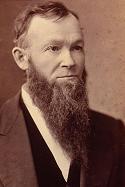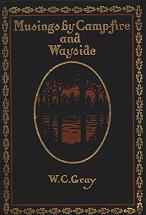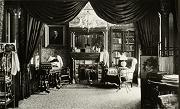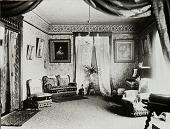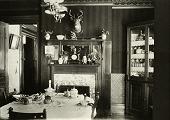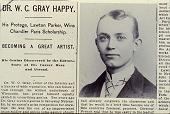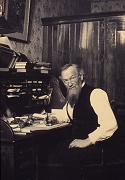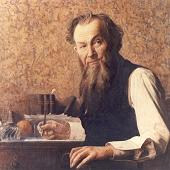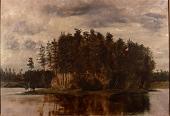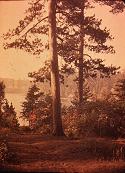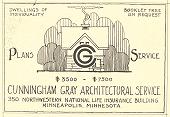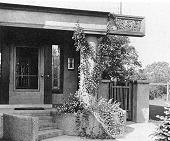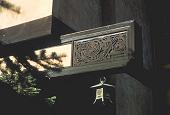|
|
|
Purcell and Elmslie, Architects Firm active :: 1907-1921
Minneapolis, Minnesota :: Chicago,
Illinois |
Ye Older Grindstones
10/10/2004
William Cunningham Gray
1871
Sawed wood panel (finish stripped while undergoing restoration)
Edna S. Purcell residence [Lake Place]
Minneapolis, Minnesota 1913
"Grandfather" Gray
1901Gray Days and Gold. In great measure, the progressive values that blossomed in William Gray Purcell were a direct distillation from exposure to the conscience and capacities of his grandfather, William Cunningham Gray, LLD. (1803-1901). Although he studied law and passed the bar in 1851 (in line with his subsequent honorary award of "Doctor of Laws"), his true vocation was to be an editor and publisher. A naturalist at heart, his philosophical expressions took the form of hundreds of "Musings" that appeared in his newspaper The Interior, usually illustrated with his own photographic plates. There were several extended series, named generally after the context in which they were written:
- Camp-Fire Musings (1883-1901)
- Attic Musings (1892-1901)
- Quaker Musings (1896)
- Mountain Musings (1897)
- Sugar Camp-Fire Musings (1897-1898)
- Wayside Musings (1899)
- Musings of the South (1895-1901)
Cover of the Fleming Revell edition, 1902 There are also a few one or two-offs: New York Musings (1889), Wilderness Musings (1887), Home Musings (1887), Laid-Off Musings (1894), Musings in a Sleeper (1895), and Assembly Musings (1898). A number of columns printed originally as "Wayside Musings" were selected by Dr. Gray to appear as "Alaska Musings" in the last and posthumous book version, Musings by Camp-Fire and Wayside (1902).
W. C. Gray residence #2
Charles C. Miller, architect
Oak Park, Illinois 1890
Library
Parlor
Dining roomDr. Gray was fiercely democratic in his cultural view. Whether adjudicating in editorial opinion the quarrels of a Presbyterian church still divided between North and South or exposing the tragic poverty caused by racial discrimination in former Confederate states, his voice was always raised for the betterment of the world in which he lived. In this attitude he carried forward the family tradition; the generation that raised him had been able participants in the underground railroad that moved escaped slaves north to freedom. He was a business partner of Cyrus Hall McCormick, who rescued the vehicle of his weekly newspaper from the rancor of competing Chicago religious nabobs by purchasing the presses outright and immediately published a statement giving complete editorial control to W. C. Gray. He was friend to Ojibway Indians just the same as he ate dinner at the White House with college classmate Benjamin Harrison.
Newspaper clipping [Chicago Tribune?] about the growing success of Lawton Parker as a tribute to the insight of W. C. Gray, 1892
W. C. Gray at his desk in The Interior offices
Photograph by Lawton S. G. Parker, 1894
Portrait of W. C. Gray
Oil on canvas
Lawton S. G. Parker 1894
Island Lake
Oil on canvas
Lawton S. G. Parker 1892Dr. Gray also fostered talent. When a young man living in rural Nebraska named Lawton S. Parker won an illustration contest held by The Interior, Dr. Gray paid for a replacement field hand to mollify Parker's father over the loss of labor. Parker attended the art school at the Chicago Art Institute, living at the Gray house with Purcell as a "big brother." He gained a succession of honors, progressed through the academies of New York, and then went on to study in Paris with James Whistler. Even after he became a prominent and sought after expatriate painter, the artist styled his name Lawton S. Gray Parker in grateful honor of his benefactor. While staying at Island Lake Camp Parker painted a life-size portrait Dr. Gray in buckskin holding a rifle to be hung in the "Chicago Hall of Fame" at the World's Columbian Exposition; later the picture was permanently attached to the foyer wall in Lake Place. Parker didn't feel the portrait was adequate and two years later painted another one of Dr. Gray sitting at his desk in the offices of The Interior.
Island Lake
Lumière autochrome
William Gray Purcell 1914
W. C. Gray with the catch of the day
Margaret Bosquet making reed floor mats for the cabins
William Gray Purcell, his brother Ralph, and cousin Dorothy Gray in an early example of organic architectural designMany "Musings" recount the summers spent at an idyllic retreat in the northern reaches of the Wisconsin forest called Island Lake Camp. Often the "Camp-Fire Musings" were written in the "Library" cabin by the light of a kerosene lamp and sent via weekly packet to The Interior office in Chicago to be published as an eagerly awaited, very popular weekly series. A number of the "Musings" later saw continued readership in several different book editions, including one in Scotland, from 1894 to 1902. For the price of a subscription to The Interior, however, everyone could share the adventure, one where foretelling events concerning the boyhood of William Gray Purcell were frequently mentioned. Between his example as an influential writer of social commentary and the environment of extended family he nurtured, both in his Oak Park home and the log cabins at Island Lake, W. C. Gray determined the framework within which grandson Purcell passed his formative years. The effect of this atmosphere on Purcell was described in an earlier essay.
Memorial Stone for William Cunningham Gray
William Gray Purcell, designer 1902
Calligraphic markers for W. C. and Catherine Gray
William Gray Purcell, designer
Alphonso Ianelli, sculptor
1965
Advertising proof
Cunningham Gray Architectural Service
1920
"Penny booklet" published in 1946 by PurcellThroughout his life, William Gray Purcell paid tribute to the memory of his grandfather. He designed the memorial marker for Dr. Gray's grave while still attending Cornell University in 1902, and added individual headstones as one of his last acts of design just before his own death in 1965. Alphonso Ianelli executed the stonework and, after being denied permission to set the stones by the cemetery, climbed over the fence in the dark of night to place them together as Purcell intended. Purcell remained in touch with Edward Sisson, the long-time assistant editor who took over The Interior, designing cover graphics, contributing articles, and exacerbating the friendship a little with his defense of Christian Science to a skeptical Presbyterian. One marketing effort in 1920 that tried to sell house plans was named "Cunningham Gray Architectural Service." During the last thirty years of his life Purcell presented his grandfather--and the life experience he represented--to new audiences in a variety of ways, most notably numerous articles published in Northwest Architect, a privately printed little "Blue Book" sent to uncountable correspondents and, especially, the posthumously published volume of his own Island Lake recollections titled St. Croix Trail Country. The love, respect, and admiration Purcell felt toward his grandfather burned brightly across an entire lifetime.
Portrait of W. C. Gray
for World's Columbian Exposition, with Dr. Gray turning to wave
Oil on canvas
Lawton S. G. Parker 1892
Portrait with dead rabbit temporarily applied on acetate sheet during restoration (humor of a sort, I suppose)
Front doorway
Edna S. Purcell residence
1913
Sawed wood panel, ca. 1950sKnowing all this now, at least in brief, and with a reminiscent nod toward Dr. Gray's pictorial presence on the wall in Lake Place, the lyrical appearance of the phrase "Gray Days and Gold" that is found on a large sawed wood panel at the entrance to the house can be better understood. In 1894 William Winter had authored a romantic book about England and Scotland with that title, which George Elmslie happened across serendipitously in 1913. Elmslie was concerned at the time with the design of the sawed wood panel and sent Purcell a note with sprightly glee at his synchronistic discovery. Purcell was equally pleased with the poetic double entendre and told Elmslie to draw the letters. Thus did a crystal of hopeful family blessing appear within the optimistic statement of principle that was named Lake Place.
Now I have to spend time bringing up the enlarged images, but for this Sunday, that's my six hours. I notice, too, that I am actually writing here and there, which means that these sorts of texts need to be placed more within the pages where that evolution toward the manuscript are meant to be seen. It's all process.
10/9/2004
Precious (1990 - 2004) In Memoriam. Distances in time take stretches long and short. Three weeks have passed since I updated this page. Although I had started the next entry, as I usually do to prime the pump, the intervention of life left my office lights darkened. On Saturday, October 2, 2004, at 2:30 pm, my beloved cat Precious left this incarnation. She had been with me through fourteen of these thin years, always present in any room at home where I sat, always attentive to any movement that might mean play, always pointing out that since I was in the kitchen getting something to eat so should she receive a morsel or three. She also came nearly every day to ask to ride on my shoulders as I walked around the apartment. She was almost always sitting on my lap, or my research materials on my desk, when I wrote all the Grinds. Her illness of failed kidneys was sudden and within a few days I had to get the vet to release her from the suffering. I am bereft in an abyss of loss and have not felt like working on much of anything except the bare minimum to keep the front door in place. My friends and family have been supportive through all this, which I appreciate, but grieving is a solitary activity.
Also, just before Precious grew ill, I was run over by a car in the Ikea parking lot and pinned against steel back cables. Had there been a concrete wall there instead of those flexible railings, I would have had both knees crushed. As things went, I was bruised and very stiff. In this midst of these events I had two root canal appointments for which I had waited three years, prompted now to inescapable necessity due to an infected mandible. Of course, the monetary strains of all these afflictions have only added to the sense of being overwhelmed. I have been treading inner pathways, not tickling keyboards, trying to come up with the means to move forward.
The other day, thus directed, I noticed that the work plan for "The Book" (as Purcell always called the idea) was ready to go on paper or the electronic equivalent. A clearing has been made somewhere within the recesses of my not-so-conscious mind. The energy is focused and deliverable. Every last objection that could be made in the excuse of unpreparedness to complete the writing has been checked and resolved. My channel is opened, the Muses are graciously near. I've only been thinking about this for twenty-five years now. Or, in the organic understanding, the act of co-generation has been burning through the continuity of the past two and a half decades--"The Book" has been thinking about me for that length of time. Distances, long and short. How do you tell them apart, really?

